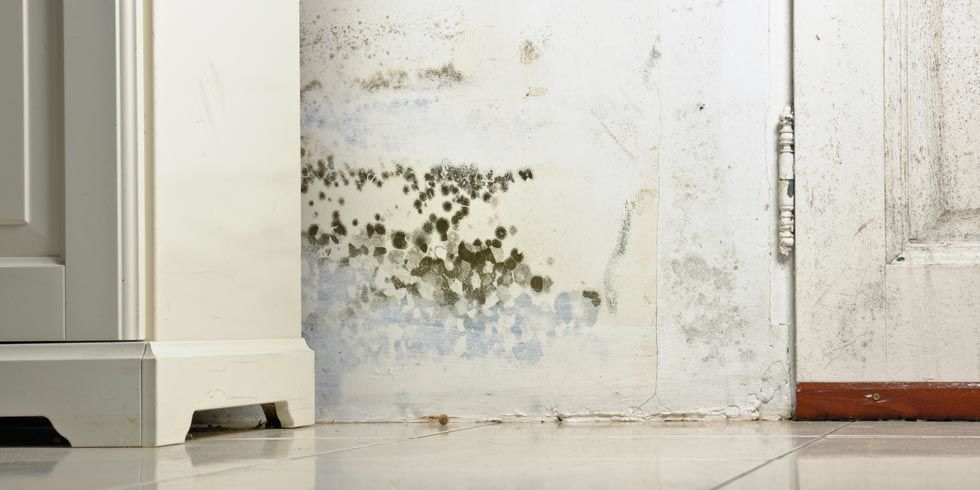We’ve all seen those white, powdery spots that coat cardboard boxes stashed in a damp basement or black gunk in the corners of the shower. It’s mildew, a mold that feeds off of fabric, wallpaper, ceiling tiles, wood or any organic surface exposed to excessive water, poor ventilation and no direct sunlight.
A small amount generally won’t make you sick, but if you don’t stop it in its tracks, the mold will spread. “It can ruin household valuables and even trigger an allergic reaction,” says Carolyn Forte, director of the Good Housekeeping Institute Cleaning Lab. Luckily, we’ve got tips to help you prevent mildew and conquer it when it does show up.
How to Prevent Mildew
Install a dehumidifier (these are our recommendations) in your home, which will help reduce moisture and stop buildup.
Avoid storing linens, books or furniture in your basement or attic if they’re known to be damp.
Always open the bathroom door after showering to allow moisture out. You should also seal grout lines every year if you have tiling. This will help waterproof your tub.
Too late? Here’s how to tackle mildew in a few common places.
Shower Curtain
Stepping into the bathtub and noticing that your shower curtain is dotted with mildew can make your skin crawl. But good news: Even if you use a plastic liner or washable plastic shower curtain, you can get it clean in your washing machine.
Wash a plastic curtain on the highest water level with regular amount of detergent, and add two to three bath towels for extra cleaning agitation. Then, hang to dry or put into the dryer on low heat or air only.
If your shower curtain is fabric or decorative, it’s best to wash it following the instructions on its care label. Or, to quickly freshen it, pop it into the dryer on air or fluff with a fabric softener sheet.
Bathroom Grout
Mix 3/4 cup of chlorine bleach with 1 gallon water. Wear rubber gloves and eye protection. Use a stiff brush to apply to one small area at a time. Be careful not to let the liquid spatter onto surrounding surfaces. Let it sit for several minutes, then scrub and rinse.

Fabric
That means gym clothes or that wet towel you left in the corner of your room. First, take it outside, brush off the mildew spores (a stiff brush works best) and sun dry the item for about three hours. Then machine-wash whites with chlorine bleach or presoak colored fabrics for 30 minutes in liquid nonchlorine bleach. Rinse and launder. This method also works on plastic shower curtains and liners, just skip the first step and wash in warm water using the gentle cycle.
Wood Surfaces
To remove mildew from wood cabinets, paneling or furniture, vacuum the loose spores with the soft brush attachment. Then, clean small areas using a well-wrung cloth dipped in a few squirts of Good Housekeeping Seal holder Cascade Complete ActionPacs Dishwasher Detergent ($13, amazon.com) and a gallon of water. Rinse with a clean water-dampened cloth and dry immediately with a fan. Don’t oversaturate the wood, as it could warp and damage the finish. If a cloudy film forms, wipe the area with mineral spirits. Otherwise, apply a thin coat of GH Seal holder Weiman Furniture Polish ($36 for a 6-pack, amazon.com) to restore the shine and protect the finish.
Mattresses or Upholstery
Start by vacuuming the entire item, then toss the vacuum filter and the bag when you’re through to prevent mildew spores from escaping into the air the next time you vacuum. If any stains remain, sponge the surface with a cloth moistened in 1 cup rubbing alcohol and 1 cup warm water — but do a spot test on a hidden area first to make sure the fabric won’t be damaged. To rinse, do a second wipe with a water-dampened sponge. Sun dry the sofa or mattress for several hours to remove odors or use a fan. Spray with a disinfectant like Lysol ($10 for a 2-pack, amazon.com) to kill spores that can linger in thick padding. If your furniture still smells musty or stains reappear, throw the item out.
Painted Walls
Mildew can quickly take root on walls, especially if the ventilation is poor. At the first sign of growth, mix 3/4 cup bleach with one gallon of water. Wearing rubber gloves, apply with a soft scrub brush. Let the solution penetrate for 15 minutes before rinsing with water. Dry thoroughly with a fan for about a half hour. If stains reappear, you may have to replace the wallboard.

Old Books
Air the pages outside on a sunny, breezy day for at least three hours. Once they’re dry to the touch, brush off the mildew with a dry cloth. Remove stains by wiping them gently with a soft cloth dipped in a solution of 1 part chlorine bleach to 4 parts water (wring it well first). Repeat the process using another soft cloth dipped in water to gently sponge away the chlorine, but don’t rub or oversaturate the paper. Pat or fan-dry the pages. You can speed up the drying process by sprinkling cornstarch or baking soda on each page to absorb remaining moisture, then wipe it off with a soft, clean paint brush.













